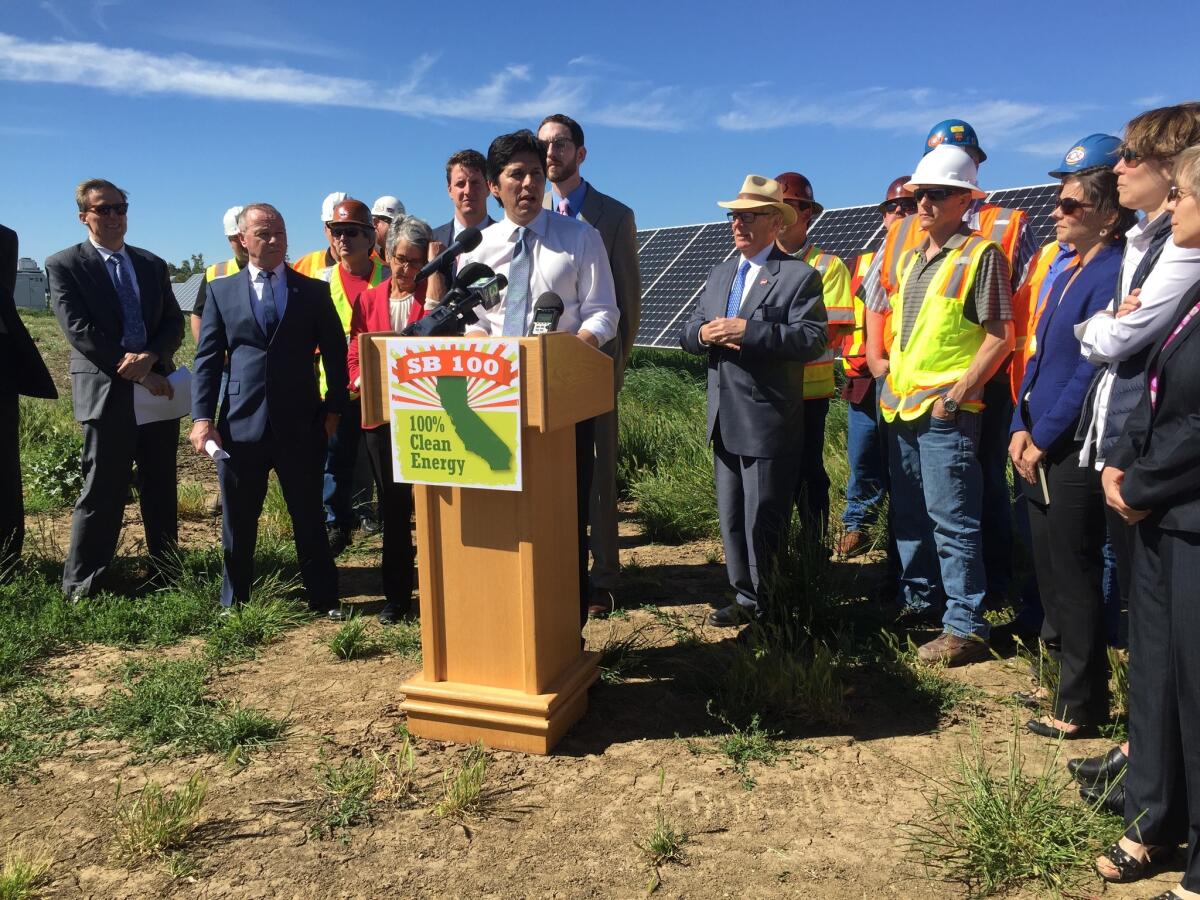California set an ambitious goal for fighting global warming. Now comes the hard part
When Stanford University energy economist Danny Cullenward looks at California’s policies on climate change, he sees a potential time bomb.
The state wants to slash greenhouse gas emissions so deeply in the coming years that oil refineries and other industries could face skyrocketing costs to comply with regulations, driving up gasoline prices until the system loses political support. If that happens, an effort touted as an international model for fighting global warming could collapse.
Not everyone agrees with Cullenward’s assessment, but it reflects how experts, officials and lawmakers are starting to reckon with the state’s steep ambitions and the understanding that its current policies may no longer be adequate. Although California has been gliding toward its initial goal of reducing emissions to 1990 levels by 2020, it must cut an additional 40% by 2030 under a law signed by Gov. Jerry Brown last year.
“It’s going to take bold proposals to get us to where we need to be,” said Cullenward, who has helped shape legislation in the Capitol.
Getting the details right means the difference between California burnishing its role as an incubator for innovation or proving itself to be a canary in the coal mine, and lawmakers are sorting through a flood of ideas this year. One proposal would accelerate the adoption of renewable energy and eventually phase out all fossil fuels for generating electricity. Some advocates want a regional power grid to share clean energy across state lines. Everyone is looking for ways to turn climate policies into jobs in their local communities.
“We’ve already decided as a state and as a Legislature that we want to dramatically reduce pollution and move forward toward a clean energy future,” Senate leader Kevin de León (D-Los Angeles) said. “That debate is over. Now we’re deciding how to get there.”
Those conversations, however, could prove just as contentious as previous debates, expose divisions among environmentalists and force lawmakers to make difficult decisions about squeezing a state with the world’s sixth-largest economy into a dramatically smaller emissions footprint.
“Everything is a huge question mark,” said Rob Lapsley, president of the California Business Roundtable, which represents the state’s largest corporations.
Front and center is the haggling over extending the cap-and-trade program, which requires companies to buy permits to release greenhouse gases into the atmosphere. Permits can also be traded on a secondary market. It’s the only system of its kind in the country, and it faces steep legal challenges that can only be fully resolved with new legislation to keep it operating.
Brown wants to settle the issue next month, and there’s wide consensus around keeping the program in some form. Oil companies that once launched an expensive ballot campaign to block it are now negotiating its extension — albeit on terms that are friendlier to their industry — and even some Republicans are on board with the idea.
But there are still disagreements over how to move forward, some of which were highlighted with the recent release of a proposal Cullenward worked on with one of his Stanford colleagues, environmental law professor Michael Wara.
The legislation, SB 775, which was written by Sen. Bob Wieckowski (D-Fremont) and backed by De León, would create a higher minimum price for emission permits and increase it annually to provide a steeper incentive for companies to clean up their operations.
There would also be a firm ceiling on how high prices could climb to guard against sticker shock as permits become more valuable while the state ratchets down emissions to meet its 2030 goal.
The legislation would make another significant change. Instead of sending cap-and-trade revenue only to projects intended to reduce emissions, such as subsidies for electric cars or affordable housing near mass transit, a chunk of the money would be distributed to Californians — much like a tax rebate.
Although it’s not yet clear how the rebates would function, the proposal is an acknowledgement that costs for gasoline and electricity are likely to rise, and lawmakers want to help insulate voters from the effects. The state’s transition toward low-emission technology could prove expensive over time, requiring the purchase of millions of electric vehicles and shuttering natural gas operations in favor of new solar plants.
“This is a massive infrastructure replacement program for California,” said Snuller Price, senior partner at E3, an energy efficiency consulting firm that has worked with state regulators. “We’re swapping out all of our things.”
Wara said California needs different policies to set a new target.
“It’s a totally different animal. We need to acknowledge that,” he said. “It’s going to a level of [emissions] reductions that no one has ever achieved.”
The idea has been embraced by some policy wonks — “state of the art,” one writer proclaimed — but others see peril in this approach. No longer would companies be able to finance offsets — green projects intended to lower emissions anywhere in the country — to meet their obligations under the program, cutting the flow of cash from California industries to environmental efforts nationwide.
The legislation also includes a modification to the program that some environmental advocates fear would make it harder to ensure the state meets its goals. Under the new proposal, the state would sell an unlimited number of permits if prices reach the ceiling, rather than restricting how many are available as the program does now.
That adjustment would make cap and trade function more like a tax, said Nathaniel Keohane, vice president at the Environmental Defense Fund, which is critical of the proposal and doesn’t see the same threat of price spikes.
“It’s a fundamental, philosophical thing,” he said.

De León wants to accelerate the process of reducing emissions from generating electricity. He launched new legislation, SB 100, to require the state to use renewable sources such as wind and solar for 60% of its power by 2030, up from the current target of 50%. By 2045, the use of fossil fuels such as coal and natural gas to generate electricity would no longer be allowed.
It’s a big climb — about 20% of the state’s electricity came from renewable sources in 2015, the latest figures available. The proposal has been embraced by labor groups who see jobs in building new infrastructure, but some are skeptical.
Brent Newell, legal director at the Center on Race, Poverty and the Environment, doesn’t want to see incentives for producing bio-gas from cow manure at industrial-scale dairies, which are a source of air and water pollution.
Although the legislation is “pointing the compass” in the right direction, he said, “that’s not clean energy.”
Reaching the point where fossil fuels aren’t used to keep the lights on will require new approaches to California’s electricity grid. Renewable sources can be difficult to manage because it’s impossible to control when the sun shines or the wind blows. The challenge is finding ways to soak up electricity when there’s too much, such as charging batteries or pumping water into reservoirs, and then releasing it when needed.
Another approach involves integrating California’s grid with other states, providing a wider market for excess solar energy that’s produced here on sunny days and allowing more wind energy to flow in from turbines elsewhere in the region.
“There’s a huge amount of efficiency to be gained,” said Don Furman, who directs the Fix the Grid campaign.
The idea would require California to share control of the electricity grid with other states, which unnerves some lawmakers and advocates. Unions also fear changes that would make building energy projects more attractive outside of California.
Debates over these issues are drawing the most attention in the Capitol, but other proposals are bubbling up as well, a sign that many lawmakers want to get involved in the issue.
One measure would make it easier for low-income Californians to access solar power. Another would create a system for tracking electricity consumption to help pinpoint areas for more efficiency.
“A lot of small steps create big momentum,” said Lauren Navarro, a senior policy manager at the Environmental Defense Fund. “These are pieces of what it takes to get to a clean-energy economy.”
Twitter: @chrismegerian
ALSO
Trump is creating a void on climate change. Can California persuade other states to help fill it?
The fight against climate change in California gains an unlikely ally: Republicans
Updates on California politics








